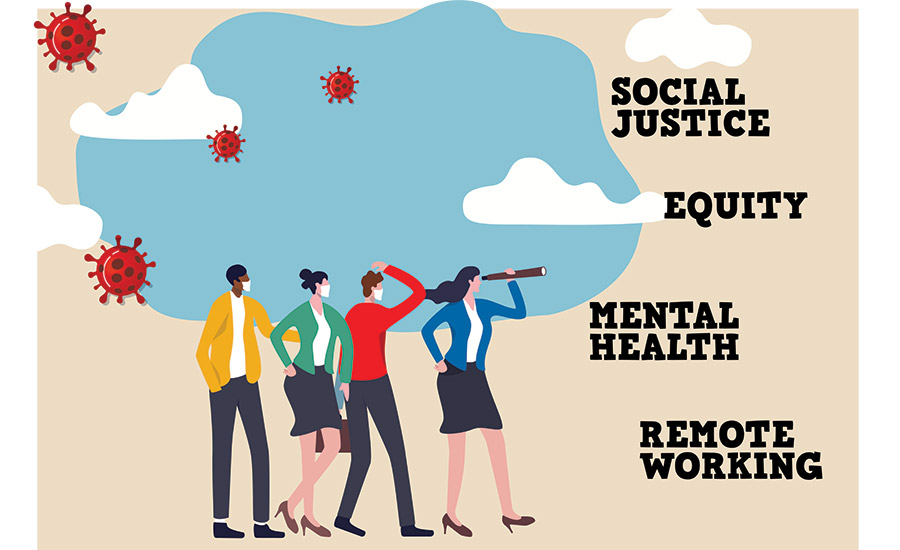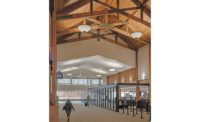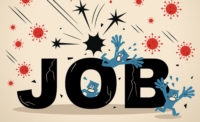“Nimble” is frequently used to describe how AEC human resources leaders responded to the cascade of challenges in the past year. On top of supporting field crews to help keep jobsites safe and productive amid Covid-19 outbreaks, HR teams scrambled to craft strategies for maintaining connections across a suddenly dispersed office workforce, sustain recruiting efforts with only limited access to prospective candidates and conduct sometimes difficult discussions of social justice issues raised by the Black Lives Matter movement.
Though existing crisis plans gave some firms a head start on shaping responses to some of those challenges, guidance for others was virtually non-existent.
“There was no playbook for a global pandemic,” recalls Nicole Calamaio, chief HR officer for Tempe, Ariz.-based Sundt Construction Co. “We were making decisions quickly in areas where we didn’t have a lot of expertise.”
More than 18 months later, HR teams can be cautiously proud of having shepherded their companies from one iteration of the new normal to the next. But now they find themselves faced with an equally knotty task—maintaining a high level of agility, not only to sustain those efforts, but also to keep their organizations in step with whatever dynamics the future holds.
For example, HR professionals agree that the past year has substantially changed employee expectations, particularly in the area of work locations. While some people have welcomed the opportunity to return to 9-to-5 routines with the lifting of pandemic restrictions, others have sought to preserve the more flexible schedules and safety advantages of working remotely. They also welcomed their employers’ stepped-up communication efforts to keep dispersed workers connected as the pandemic unfolded.
“Employees expect more flexibility and more transparency,” says Julie Kellman, vice president of HR for Pepper Construction Group, Chicago. “We’ve raised the bar on ourselves to share more information, and we will have to continue doing it.”
Maintaining a virtual workforce for the long term may be easier said than done, however. As companies look for ways to implement hybrid models that combine home and office work hours, striking an optimal balance may well prove to be a bigger challenge than sending everyone home at the outset of the pandemic.
Accommodating requests for greater flexibility is one thing, explains Rob Barclay, chief HR officer for Richmond, Va., A/E firm Draper Aden. “But you also want to maintain your culture and have the right level of collaboration, communication and social interaction in the office,” he adds. “That’s particularly important for employees new to the industry, who are still building their professional skill sets.”
Nor are all managers fully equipped to manage a virtual workforce. Setting expectations, goals and monitoring performance “is going to be an ongoing effort,” Barclay adds.
ATCS, a Herndon, Va.-based consulting engineering firm, is among the organizations that have significantly revamped their approach to remote work. What had been a formal process for considering such requests has largely been replaced with more streamlined employee-manager discussions on performance expectations and accessibility.
“We’re a completely different organization now,” says ATCS human resources vice president Sherri Huntley.
Though some firms want to be flexible, they may be limited by contractual and operational relationships with clients and partners as to what can be done. “Our clients have certain expectations of our project teams,” explains Lauren Nunnally, vice president and chief talent officer for Swinerton, the San Francisco-based contractor and construction manager. “Altering team presence on site could present challenges that we need to be sensitive to.”
Still, industry HR consultant Juli Smith warns that insisting on a full return to pre-pandemic office routines could ultimately prove detrimental.
“Staying too rigid will affect retention and the ability to attract people,” Smith warns, citing anecdotal evidence of rejected job offers because of strict limits on working from home.

Original image courtesy of Getty Images
Stress Signals
The pandemic’s usurpation of office and jobsite routines also put the spotlight on employee mental and emotional wellness, an issue that industry HR professionals agree has not always received the attention it deserved but can no longer be ignored.
“The pandemic really opened up a discussion that had been taboo, and swept under the rug,” Calamaio says. “It’s much easier to talk about it now.”
Nunnally agrees, saying that in addition to looking at further mental health resources and benefits for both office and jobsite employees, “it’s important to train all of our managers and leaders on how to effectively lead in this space—how to check-in with employees, what to pay attention to and how to offer and show support.”
Also difficult, but just as important, were the deeper conversations on diversity and inclusion sparked last summer as Black Lives Matter marches took place across the country. Many HR leaders report having refined their existing minority recruitment and mentoring plans to make measures more intentional, from designating executives to championing diversity, to conducting focus groups to discuss where existing efforts have both succeeded and fallen short.
“The events of last summer were an amazing jolt to all of us,” says Kellman. She adds that Pepper Construction quickly formalized its long-standing approach to diversity into a five-pillar framework that the company can use “to lean into all diversity and inclusion efforts—employees, trades, subcontractors and customers.”
Such discussions and actions will also be necessary to meet the changing expectations of prospective employees as the competition for skilled talent continues to intensify. “People expect an organization to be focused on inclusion and diversity,” Huntley says. “They’re asking questions about what we’re doing, so we need to be sure our hiring managers can answer them.”
At the same time, a firm’s commitment to diversity also demands a commitment to respect all viewpoints. Nunnally recalls being somewhat surprised to see some polarization within Swinerton’s employee base regarding subjects perceived as political on some level.
“This really forced us to think very carefully about what rules, policies and programs we wanted to put in place and, more importantly, how we wanted to message them,” she says. “Trying to figure out how to communicate in a way that resonated with all employees while creating safe and inclusive work environments was challenging.”
Listening and Learning
Listening to employees’ changing needs and concerns may well be the key to the successful evolution of AEC human resources. Many firms already are making more frequent use of surveys and other information-gathering techniques to gauge the sentiment of staff members. Some post-pandemic challenges already are taking shape, from gradually loosening state and local laws on marijuana possession and use to accommodating leave requests for religious observances that up to now have not appeared on traditional company holiday calendars.
“Employee engagement is a must, and that includes listening and responding to what they say,” Smith says. Given the demand for talent and people’s newfound ability to work seamlessly from almost anywhere, she says, “they can more easily look elsewhere than before.” While such communication will be critical, “we have to remember that we’ll still have a multigenerational workforce, with different ways of accessing information,” cautions Sally Tate, vice president of people strategies for Richmond, Va. -based Hourigan, a contractor. “The future will be one of constant adaptation.”
Despite the uncertainties that may lie ahead, Sundt’s Calamaio says a willingness to do whatever is necessary to treat employees well and respond to their needs will provide HR departments with the necessary nimbleness to continue their ongoing evolution. “Things are moving faster than ever,” she says, “but it ultimately still comes down to caring.”






Post a comment to this article
Report Abusive Comment